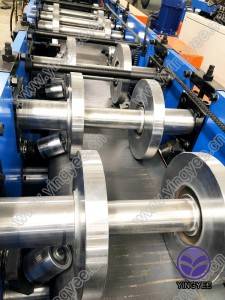
Understanding the Simple Slitting Line A Comprehensive Overview
In the world of manufacturing and metalworking, efficiency and precision are paramount. One of the key processes that facilitate the handling of metal sheets and coils is the slitting line. Specifically, the “simple slitting line” is an essential piece of machinery designed to cut wide rolls of material into narrower strips with exact dimensions. This article will explore the functionality, advantages, and applications of simple slitting lines in modern industries.
What is a Simple Slitting Line?
A simple slitting line is a type of continuous production system that takes large rolls of metal, typically hot-rolled or cold-rolled steel, and slices them into narrower strips. The process usually involves unwinding the material from a large coil, feeding it through a series of rotary blades, and then rewinding the cut strips into smaller coils. These strips can vary in width, depending on the requirements of the end users.
The basic components of a simple slitting line include the uncoiler, a tension leveller, rotary cutting blades, and a recoiler. The uncoiler unwinds the large coil of material, while the tension leveller ensures that the metal is flat and uniform. The rotary blades, set at exact intervals, slice the material into strips. Finally, the recoiler collects the finished strips into smaller coils.
Advantages of Simple Slitting Lines
1. High Precision One of the standout features of simple slitting lines is their ability to provide precise cuts. The rotary blades can be adjusted with high accuracy, ensuring that each strip meets specific width and thickness requirements. This is crucial for industries that rely on exact measurements for further processing.

2. Efficiency Simple slitting lines are designed for high-speed production. They can operate continuously, reducing downtime and increasing output. This efficiency is critical in a fast-paced manufacturing environment, where time often translates to money.
3. Flexibility These slitting lines can handle various materials, including different grades of steel and other metallic and non-metallic materials. Moreover, operators can often adjust the line’s settings to produce strips of various widths without requiring extensive resets, enhancing production flexibility.
4. Reduced Waste By ensuring precise cuts, simple slitting lines contribute to minimizing material wastage. Unused or over-cut material can significantly raise production costs, so the efficiency of a slitting line helps mitigate this challenge.
Applications of Simple Slitting Lines
Simple slitting lines are used in various industries, including automotive, construction, and appliance manufacturing. For instance, in the automotive industry, slitting lines are indispensable for producing components that require specific metal strip sizes for durability and performance. Similarly, the construction sector uses slitted coils for fabricating panels, roofing materials, and other essential elements. Appliance manufacturers also rely on accurately slitted strips for creating the casing and structural parts of various appliances.
Conclusion
The simple slitting line plays an essential role in contemporary manufacturing processes. With its combination of precision, efficiency, and flexibility, it not only meets the needs of diverse industries but also helps companies maintain competitive edges in their respective markets. As technology continues to evolve, the designs and capabilities of slitting lines are likely to improve further, driving enhanced productivity and sustainability in metal processing. Understanding the importance of simple slitting lines can help businesses make informed decisions about their manufacturing processes and investments in technology.